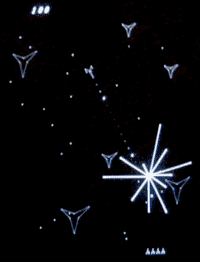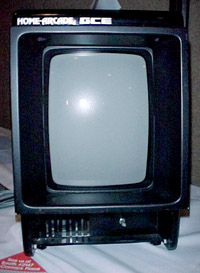 |
|
|
|
Vectrex Arcade Game System
The Vectrex originated at Western Technologies/Smith Engineering, when some of the engineers wanted to find a way to use a bunch of the cheap cathode ray tubes (CRT's) they had just purchased.
An all in one vector gaming system was decided, and the rest is history. The Vectrex was marketed by General Consumer Electronics (GCE) in USA and Milton Bradley (MB) on the international market.
Vectrex System Sub Pages
|
|
The legendary Vectrex is the world's only standalone vector graphic home video game system. The GCE Vectrex Arcade System was introduced in June 1982 at the Summer CES show and became available for purchase at $199 in October that year. This system was noteworthy for using vector graphics to display images on the monitor. Read more about the Vectrex history.
 |
What's a Vector Graphic?
For those that have no idea of a vector vs. raster display - a quick explination: Most game displays use what is called a raster display where the electron gun that displays pictures on the screen (such as a Television set) scans down the screen horizontally anywhere from 30 to 60 times a second, drawing small blocks called pixels. Vector graphics have the gun draw to exact locations only using x and y coordinates. Because of this, they obviously require special electronics for this type of display mechanism.
The plus side is that the lines and details drawn are much cleaner and crisper than it's raster counterpart. This provides for great wireframe 3D effects. The bottom side is that color graphics become a bit more complicated, and solid graphics (non-wireframe) are next to impossible. Vector graphics had been in use with coinop arcade games in the late 1980's, starting with Cinemetronics Space Wars in 1978. Probably the most famous vector graphic game is of course Atari's Asteroids.
The Vectrex was sold with a build-in game, Mine Storm, a derivative of the arcade hit Asteroids. The other games were sold on cartridges, which could be plugged into the right side of the console. All together more then thirty different cartridges appeared in the stores. Read more about the original Vectrex games. |
In 1984 GCE introduced the Light Pen and 3-D Imager and used the name Vectrex Graphic Computer System with plans to provide a keyboard with BASIC and a wafer tape storage device. The head-mounted 3-D imager was unique in that it achieved both 3D and color images by putting a spinning wheel in front of the viewer's eyes that contained red, green, blue and opaque black sections.
The Vectrex's base technical specifications were impressive. It used the speedier and more advanced Motorola 68A09 (6809) instead of the cheap MOS Technology 6502 8-bit microprocessor found in early Apple, Atari and Commodore computers. Likewise, its sound generator, a General Instrument AY-3-8910, supported a competitive three simultaneous channels of sound with a dynamic range of effects. The chip had been used in Mattel's earlier Intellivision (1980) and would show up in the Atari ST (1985) and other computer systems.
Vectrex Circuit Board
- CPU : Motorola 68A09 @ 1.5 MHz
- RAM: 1 KB (two 4-bit 2114 chips)
- ROM: 8 KB (one 8-bit 2363 chip)
Vectrex Sound
- Sound: General Instruments AY-3-8912
- 3" electrodynamic paper cone speaker
Vectrex Specifications
Year: 1982
Country: U.S.A.
Model: HP3000
Codename: Mini Arcade
CPU: Motorolla 68A09
Speed: 1.6MHz
Coprocessors: GI AY-3-8912 (Sound, controller I/O)
ROM: 8 KB rom cartridges (8KB×8-bit 2363)
RAM:1 KB (two 4-bit 2114 chips) (IC204, IC205)
Graphic: Modes Vector, with built in 9 x 11" screen
Colors: B&W, Color (rgb) available with 3D goggles
Sound: 3 tone generators and wave shaping, built in 3" permanent magnet speaker
I/O Ports/Addons: volume, brightness and reset controls,
cartridge port, 2 controller ports, 3D goggles, light pen
|
|
The look and feel of the Vectrex goes to Walter Nakano and Colin Vowles. Both model builders, they created the unique look of the Vectrex system a full 2 years before the Macintosh computer came out with it's similar look.

The prototype Vectrex shown at CES |
The Vectrex Controller was also innovative in numerous ways. It was designed with an arcade experience in mind. Even the way the controller folds out of it's storage compartment on the Vectrex console makes it look like a miniature arcade game. The rectangular box was large enough to be stable and sit on a desktop. Mounted on it were 4 fullsize arcade buttons and a sturdy top heavy joystick on the left. The controller itself was detachable and connected to the Vectrex through a Atari Joystick plug type connection. There were two controller slots made available to be plugged in to on the Vectrex unit itself, allowing for realtime two player games.
The Vectrex Joystick - The Vectrex was the first home console to feature analog joysticks. Most arcade games and consoles had 8-directional (or fewer) controls. The design decision to go with analog was most likely because of the nature of the console. With vector graphics, 3D games are more common and lines/objects aren't as locked into the cardinal "8 directions" like traditional raster hardware.
The Cathode Ray Tube (CRT) Display was a Samsung model 240RB40 monochrome unit measuring 9 x 11 inches, displaying a picture of 240 mm diagonal. A vector display such as the Vectrex does not require a special tube, and differs only in the control circuits. Rather than use sawtooth waves to divert the internal electron beam in a raster pattern, digital-to-analog converters drove the horizontal and vertical deflection magnets. Such technology was already established by arcade games such as Asteroids. The Vectrex did not have any luminance control, but rather brightness was adjusted by drawing some lines more frequently than others. |
The Vectrex was a black & white system, but achieved color by using overlays on the screen in much the same way as the Magnavox Odyssey and some of the early full-size video arcade games. Because the Vectrex had a black & white monitor, it was decided to supply every game with its own coloured and transparent overlay, that could be attached to the screen. The overlays livened up the games and moreover protected the eyes for the bright and a bit blinking light that was typical of the vector technique. Read more about the Vectrex history.
|
|
|
|
|